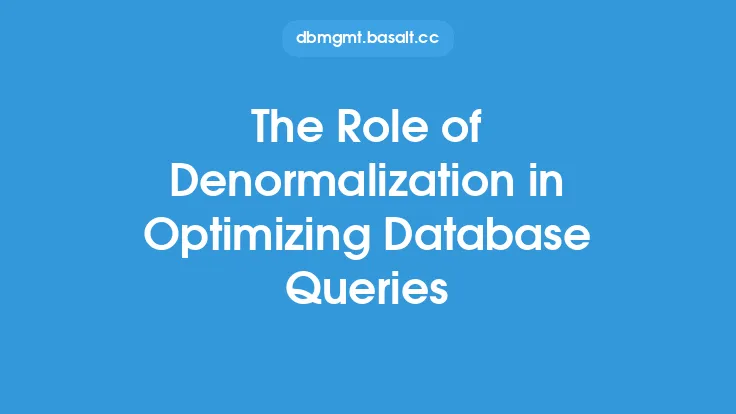In the realm of database management, denormalization is a technique used to improve the performance of a database by reducing the number of joins required to retrieve data. This is achieved by storing redundant data, which can lead to faster query execution times. However, denormalization also introduces additional complexity and potential data inconsistencies, making it a trade-off that database administrators must carefully consider.
Introduction to Denormalization
Denormalization involves deliberately deviating from the principles of normalization, which aim to minimize data redundancy and dependency. Normalization is a fundamental concept in database design, ensuring that each piece of data is stored in one place and one place only. Denormalization, on the other hand, allows for the duplication of data to enhance query performance. This technique is particularly useful in databases with complex queries or high transaction volumes, where the overhead of joins can significantly impact performance.
Benefits of Denormalization
The primary benefit of denormalization is improved query performance. By reducing the number of joins required to retrieve data, denormalization can significantly decrease query execution times. This is especially important in applications where fast data retrieval is critical, such as in real-time analytics or high-traffic web applications. Additionally, denormalization can simplify complex queries, making them easier to maintain and optimize. Furthermore, denormalization can also reduce the load on the database, as fewer joins mean less computational overhead.
Trade-Offs of Denormalization
While denormalization offers several benefits, it also introduces some significant trade-offs. One of the primary concerns is data inconsistency, which can arise when redundant data is not properly synchronized. This can lead to errors and inconsistencies in the data, making it difficult to maintain data integrity. Moreover, denormalization can increase storage requirements, as redundant data takes up more space. This can be a significant issue in large databases, where storage costs can be substantial. Finally, denormalization can also make database maintenance more complex, as changes to the data must be propagated to all redundant locations.
Types of Denormalization
There are several types of denormalization, each with its own strengths and weaknesses. One common approach is to use a summary table, which stores pre-aggregated data to reduce the need for complex queries. Another approach is to use a materialized view, which stores the result of a query in a physical table, reducing the need for repeated calculations. Additionally, some databases use a technique called "data warehousing," which involves denormalizing data into a separate database optimized for querying and analysis.
Implementing Denormalization
Implementing denormalization requires careful planning and consideration. Database administrators must identify the queries that will benefit most from denormalization and determine the best approach to achieve the desired performance gains. This may involve creating summary tables, materialized views, or using other denormalization techniques. Additionally, administrators must also consider the potential trade-offs, such as increased storage requirements and data inconsistency, and develop strategies to mitigate these issues.
Best Practices for Denormalization
To get the most out of denormalization, database administrators should follow some best practices. First, denormalization should only be applied to queries that are critical to the application's performance. Second, the denormalized data should be carefully synchronized to ensure data consistency. Third, storage requirements should be carefully considered, and strategies should be developed to minimize storage costs. Finally, denormalization should be regularly reviewed and optimized to ensure that it remains effective and efficient.
Conclusion
Denormalization is a powerful technique for improving database performance, but it requires careful consideration and planning. By understanding the benefits and trade-offs of denormalization, database administrators can make informed decisions about when and how to apply this technique. With the right approach, denormalization can significantly improve query performance, simplify complex queries, and reduce the load on the database. However, it is essential to weigh the potential benefits against the potential trade-offs and develop strategies to mitigate the risks associated with denormalization. By doing so, database administrators can unlock the full potential of their databases and provide fast, reliable, and efficient data access to their applications.





